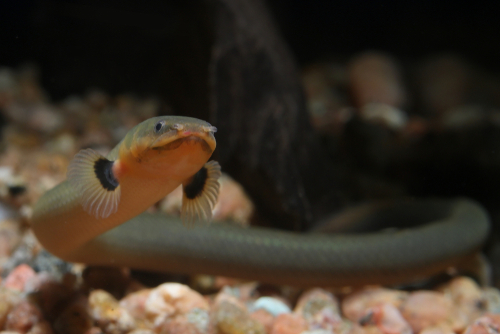Snakes are sneaky and elusive and a major fear of some, but some understand the beauty behind their mystery. Even within various bodies of water, there are fish slithering around in the water and looking almost exactly like snakes.
It’s fairly well-known that the eel is the snake of the sea, but there are so many other types of fish within the waters that look like a snake.
In fact, there are 15+ fish that look like snakes to varying degrees. Some are almost indistinguishable, while others have various physical attributes that resemble those of snakes.
Not all of the fish on this list are to be feared like a snake is, though that’s not to say that some don’t have the same kind of bite or poisonous abilities as snakes do.
The following are just some of the fish that look like snakes:
- Snake Eel
- Fire Eel
- Lamprey
- Northern Pike
- Violet Goby
- Lungfish
- American Eel
- Hagfish
- Asian Swamp Eel
- Zebra Moray
- Ropefish
- Kuhli Loach
- Northern Snakehead
- Eelpout
- Pipefish
- Bichir
- Moray Eel
- Frilled Shark
Contents
15+ Fish That Look Like Snakes
Other similar posts:
- Popular Fish That Look Like a Stingray
- Can Betta Fish Live with Goldfish?
- Popular Fish That Look Like Dragon
- Popular Fish With Ugly Teeth
1. Snake Eel
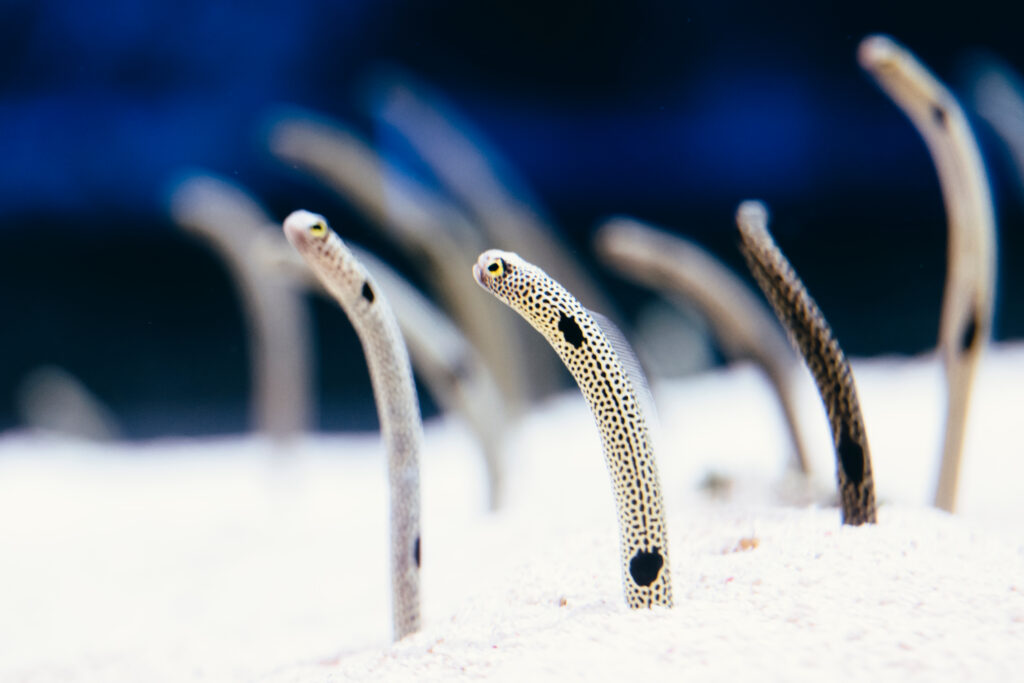
- Scientific Name: Ophichthidae
- Diet: The snake eel has a diet consisting of small fish, plankton, and different crustaceans.
There’s a reason why the snake eel has the name it does, and why it’s at the top of this list. They have the signature cylindrical shape of a snake, their heads mimic a snake’s, and they have the same smooth texture as well.
While the snake eel typically features black spots along white scales, they have the ability to hide themselves should they need to sneak up on some food or get away from a predator.
2. Fire Eel
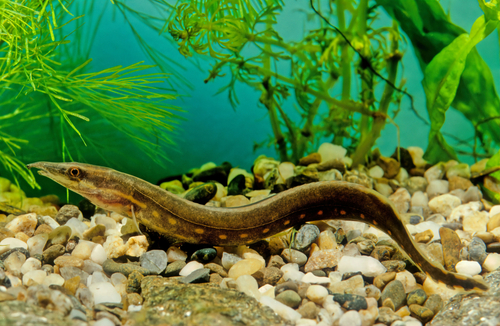
- Scientific Name: Mastacembelus erythrotaenia
- Diet: Fire eels enjoy an omnivore diet, consisting of different kinds of plants, insects, larvae, and crustaceans.
The fire eel mimics a snake not only due to its physical attributes, but because it also gives off the same scary impression that a snake does. When a fire eel opens its mouth, it almost looks as though they have fangs.
This fish can be found in variations of colors, with a thick skin and a cylindrical body structure. One of these bad boys can grow up to three feet long, making them truly intimidating like a snake.
3. Lamprey

- Scientific Name: Petromyzontiformes
- Diet: The lamprey either feasts on small organic matter found in the water, or will latch onto a fish or sea mammal and suck up their blood.
When a lamprey isn’t being misidentified as an eel, it’s usually being incorrectly labeled as a snake. Outside of its strange-looking mouth that sucks in meals, the lamprey looks like a snake in almost every other way.
It also has some fins that run along its long body, which reaches lengths of two to four feet.
One of the most alarming features of a lamprey is their mouths. Their mouth opens in a circular fashion, showcasing rows upon rows of small yet sharp looking teeth. As mentioned, they open their mouths this way to suck in their food.
4. Northern Pike
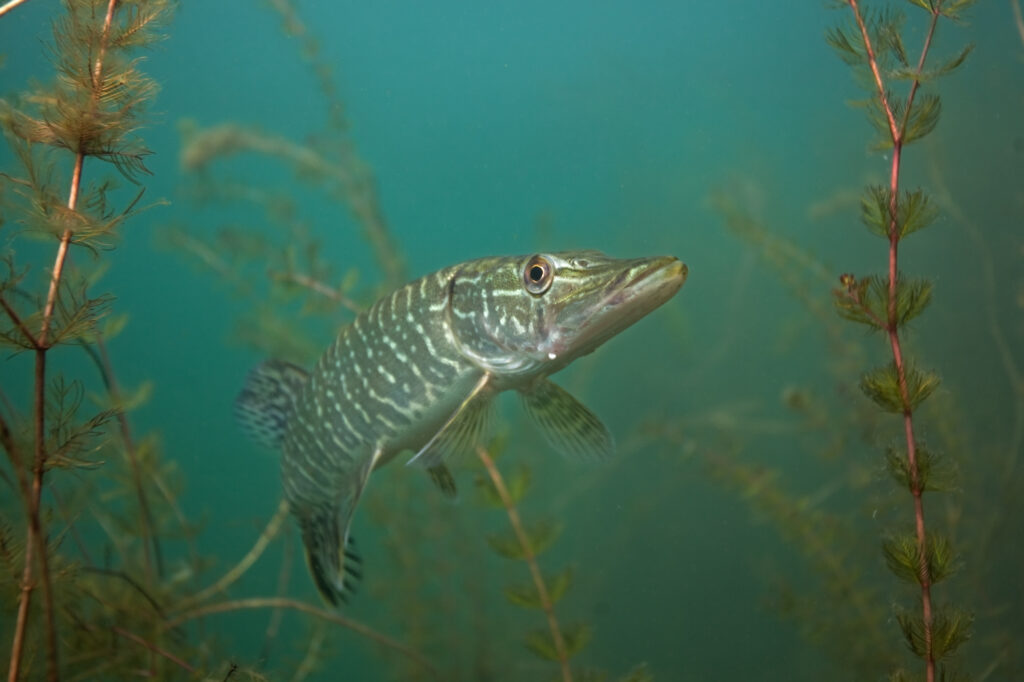
- Scientific Name: Esox lucius
- Diet: Believe it or not, the northern pike is known to eat snakes! Other than that, they also eat various other types of fish, as well as frogs and bugs.
A northern pike could be mistaken for a big snake if it didn’t have its finned tail that’s connected to a dorsal fin around its back. Their skin is comparable to snakeskin, their eyes are small, and they have an extended cylinder body. One of these fish can range from one to five feet long, making them quite an intimidating fish to pull out of the water.
5. Violet Goby

- Scientific Name: Gobioides broussonnetii
- Diet: The violet goby is a bottom feeder that eats an omnivorous diet, which includes anything from worms to algae to insects. In the wild, they will also often suck up a bunch of gravel, looking for food within it before spitting out the remaining gravel.
A violet goby is hard to miss with its stunning dark blue iridescent coloring, which sometimes features speckles of gold. While their head is a little bit larger width-wise than a snake’s is, their elongated physique is very similar.
They also have small dorsal fins along their backs and translucent fins near their head, which is why they are sometimes referred to as a dragon goby.
Furthermore, they are known for having two different colored eyes, which are typically both green and blue, making this gorgeous fish even more of a wondrous sight.
6. Lungfish
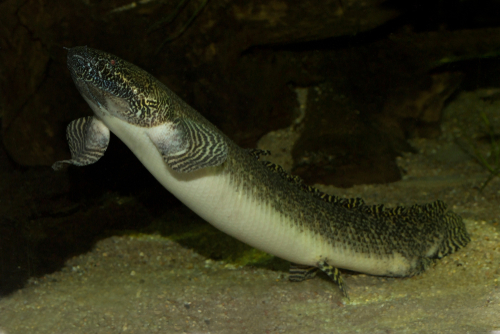
- Scientific Name: Dipnoi
- Diet: The lungfish is able to suck in prey before chomping down on it with very sharp teeth. Its favorite foods include bugs, fish, and random plant matter like roots and seeds.
Easily one of the most distinctive looking fish on this list, the lungfish has been swimming through the earth’s waters for more than 300 million years. While they are quite thick from head to tail, they have a lot of similar features to a snake. This is outside of their tail, which flattens towards the end.
7. American Eel
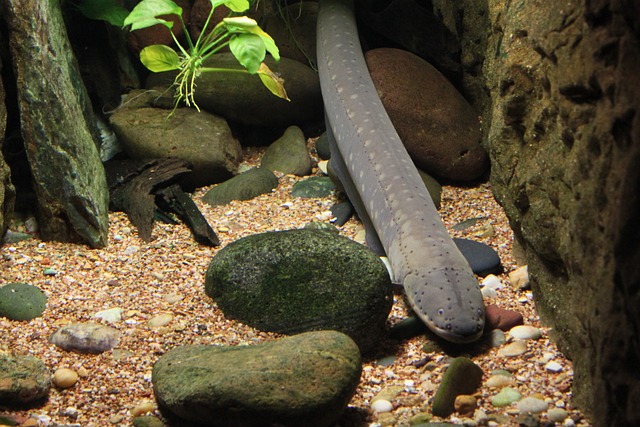
- Scientific Name: Anguilla rostrata
- Diet: The American eel will hunt for other fish at night, though outside of other aquatic life, it’s not really known what else an American eel eats.
Like many other eels, the American eel bears much of a likeness to a snake. One can see the equivalencies in the facial structure and the nose, as well as in the tube-like body.
One distinguishable feature is the straight dorsal fin on an American eel’s back. Reaching lengths of up to four feet, and are typically found along the coast of the Atlantic Ocean.
8. Pipefish
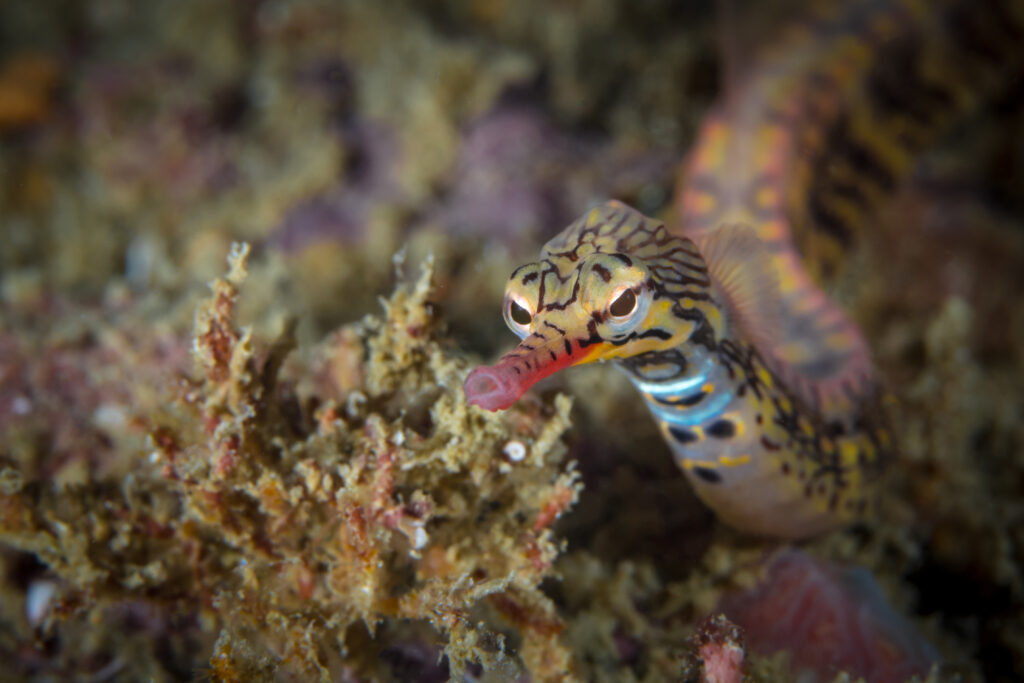
- Scientific Name: Syngnathinae
- Diet: A pipefish is known to mainly eat crustaceans, but some of them will also eat other small fish and fish eggs.
The pipefish is a sprite of a fish looking a lot like a snake outside of its long, pipe-like nose. It has that signature snakeskin pattern, with mixtures of colors sprinkled throughout their bodies.
The pipefish typically stick around a foot long at most, and use their tails to give them momentum as they swim around.
9. Asian Swamp Eel
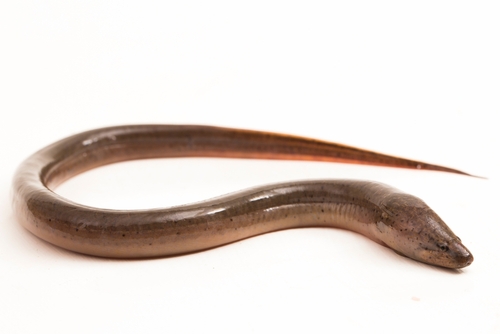
- Scientific Name: Monopterus albus
- Diet: An Asian swamp eel has a fairly varied diet, and likes to eat small fish, turtle eggs, insects, worms, and shrimp.
As the name would imply, the Asian swamp eel is found within Asian waters, though they have been found in other places. This fish, which is technically not an eel, is found spanning lengths up to a foot long.
They have the same body shape as a snake does, though their tail does thin out towards the end.
10. Zebra Moray

- Scientific Name: Gymnomuraena zebra
- Diet: The zebra moray likes a protein-rich diet of crustaceans, small fish, and mollusks.
A zebra moray gets its namesake for its black and white stripes, but otherwise, this moray looks akin to a slithery snake. Ranging between one to five feet in length, the zebra moray is shaped much like a snake from head to tail. Like a snake, they move about pretty slowly, but that doesn’t make them any less scary for their food of choice.
11. Ropefish
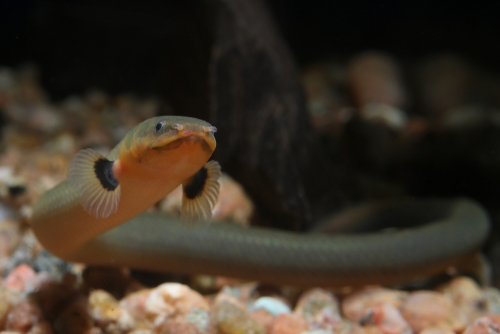
- Scientific Name: Erpetoichthys calabaricus
- Diet: A rope fish diet consists of a lot of protein, like shrimp, crab, insects, and worms.
You’d be hard-pressed to believe a ropefish wasn’t, in fact, a snake, if it weren’t for their small fins right around the bottom of their heads. From the uncanny shape of their head and face to their snakeskin-like scales, there are similarities abound.
The ropefish extends about 15 inches long, with skinny bodies and lungs that let them survive above water for quite some time.
12. Kuhli Loach
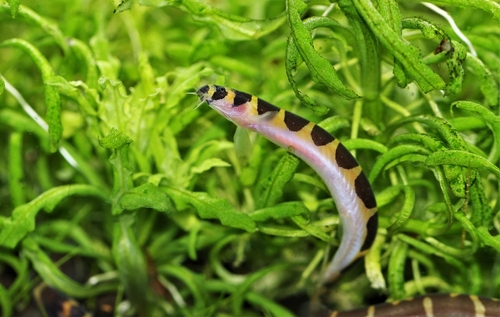
- Scientific Name: Pangio kuhlii
- Diet: Unlike many other fish on this list, the kuhli loach is an omnivore. They do like crustaceans and larvae, but will also eat a variety of plants.
From the elongated, cylindrical shape to its unique pattern, the kuhli loach very closely resembles a snake. They do have small fins and barbels, but they are so inconspicuous you would have to look closely to see them.
They have black bars along their beige bodies, and the texture of their skin looks similar to snakeskin as well.
13. Moray Eel

- Scientific Name: Muraenidae
- Diet: A moray eel is a nocturnal eater that feasts on other fish, as well as octopi, shrimp, and crab.
A moray eel looks a lot like a snake, but a thicker, larger snake. It’s also quite a vicious predator like some snakes can be. They are known for hiding themselves until they can ambush their next meal. Their bodies are long, and they have some sharp fangs of their own.
Their fairly thick dorsal fins and their random blue barbels definitely distinguish them from snakes. Interestingly enough, this dorsal fin extends from the end of their head to the back, so their tail fin is attached.
14. Northern Snakehead
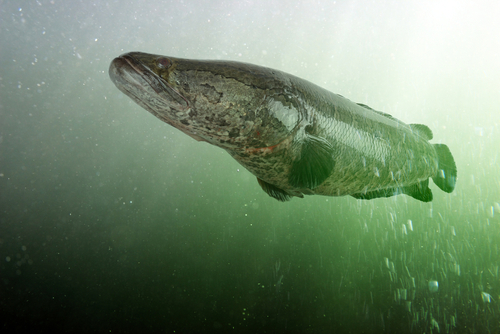
- Scientific Name: Channa argus
- Diet: A northern snakehead isn’t picky with food, and will eat anything from fish, frogs, and zooplankton to small animals and birds.
Snakeheads don’t just have a head like a snake; you can see the resemblance when looking at the pattern on their scales. They have the textured pattern and the subtle spotting like a snake.
While their shape mimics a snake, they are a lot chubbier than a snake usually is. They also have a finned tail that helps them swim around North American waters.
15. Eelpout
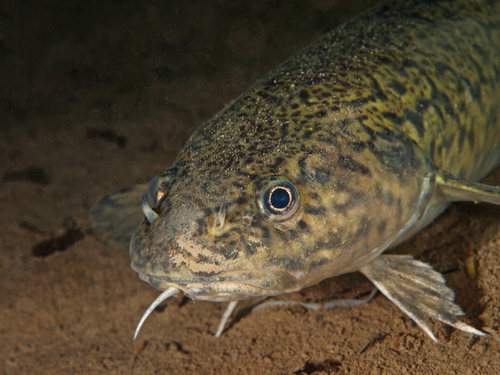
- Scientific Name: Zoarcidae
- Diet: The eelpout is ferocious with very sharp teeth that can dig into crabs, shrimp, and other fish with ease.
An eelpout is a rather strange looking fish that looks like a snake because of its face. It does also have a tube-like body, but it happens to be thicker than many of the other fish on this list. They have a long dorsal fin that extends along their back and tend to hang out very deep down into the sea.
The eelpout is also a fairly widespread fish, though they populate some areas more than others. Typically, they stay low within northern waters, such as in the Arctic and northern Atlantic oceans.
16. Hagfish
- Scientific Name: Myxini
- Diet: The hagfish is known to feed on dead fish, sometimes taking them in in one gulp.
A hagfish looks like a mixture between a snake and an eel, despite being neither. They are known to produce a lot of slime, either as a defense mechanism or just because they want to.
Their facial structure is close to a snake’s, and they have the same pipelike body a snake does that ends in a finned tail.
17. Bichir
- Scientific Name: Polypterus
- Diet: The bichir eats a carnivorous diet including other fish, worms, bug, and other sea creatures.
The bichir looks related to a snake until you get to its tail, at which point the likeness fades. This African fish has a head like a snake, and has the same textured and long body as a snake does.
What sets this fish apart includes its tail fins, as well as the dorsal fins that run along the back half of their body.
18. Frilled Shark
- Scientific Name: Chlamydoselachus anguineus
- Diet: A frilled shark feasts on many aquatic sea creatures from squids, fish, and even other small sharks.
The frilled shark is, in fact, a shark, and while it’s much larger than any snake, its head looks strikingly like a snake’s head. They are also fairly long and thin compared to most common sharks. They typically grow between five and six feet long, and they have rows upon rows of sharp teeth.
The frilled shark is a terrifying creature to look at, but once you get past how deadly they could be, you can learn how unique they are. The female frilled shark actually gets pregnant rather than laying eggs.
The good news is you’re not likely to ever encounter one of these frilled sharks while swimming about the seas.

Ian Sterling, founder of Fishlab.com, began his aquarium journey over 30 years ago, driven by a deep fascination for fish and their diverse personalities. His website, Fishlab.com, is dedicated to making fishkeeping accessible and enjoyable, offering beginner-friendly guidance, expert insights, and a community for aquarists to connect and share experiences.


